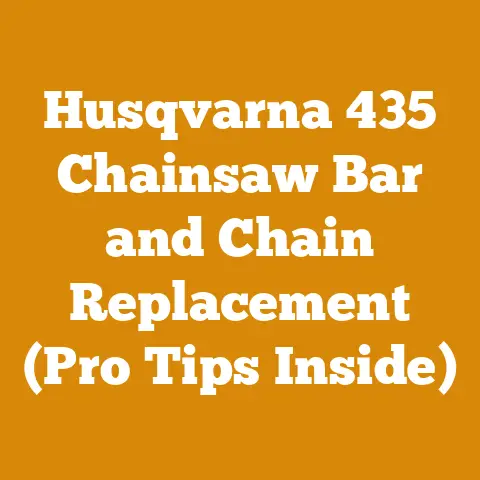Electric Chainsaw Chain Keeps Coming Off (Fix Narrow Gauge Issues)
Quick Fixes: Immediate Solutions
Before diving into the more complex issues, let’s address the quick fixes that often solve the problem:
- Chain Tension: Ensure the chain is properly tensioned.
It should be snug against the bar but still able to be pulled around by hand.
Too loose, and it will jump off.
Too tight, and it will bind and potentially break.
I usually aim for about 1/8″ to 1/4″ of sag on the underside of the bar. - Bar and Chain Compatibility: Verify that you are using the correct chain for your bar.
The chain’s pitch (the distance between rivets) and gauge (the thickness of the drive links) must match the bar’s specifications.
A mismatch here is a common culprit. - Chain Sharpness: A dull chain requires more force to cut, causing it to bind and potentially derail.
Sharpen your chain regularly using a chainsaw file or a chain grinder. - Bar Condition: Check the bar for damage, such as burrs or uneven wear.
These can impede the chain’s smooth travel.
Dress the bar with a flat file to remove any imperfections. - Lubrication: Ensure the chain is properly lubricated.
Insufficient oil can cause the chain to overheat and stretch, leading to derailment.
I always check the oil reservoir before each use.
Understanding Narrow Gauge Chains and Bars
Narrow gauge chains and bars are designed to provide faster, smoother cuts with less kickback.
However, they are more sensitive to improper setup and maintenance.
Here’s a breakdown:
- What is Narrow Gauge? Narrow gauge refers to the thickness of the chain’s drive links that fit into the bar’s groove.
Standard gauge chains are typically .050″ thick, while narrow gauge chains are .043″ or even .030″. - Advantages of Narrow Gauge:
- Faster cutting speed: Less material needs to be removed.
- Reduced kickback: Smaller cutters reduce the likelihood of kickback.
- Lighter weight: Easier to handle, especially for smaller electric chainsaws.
- Disadvantages of Narrow Gauge:
- More prone to damage: Thinner chain is more susceptible to breakage.
- Requires precise tensioning: Less tolerance for slack.
- More sensitive to bar wear: Even slight bar damage can cause issues.
Common Reasons for Chain Derailment in Electric Chainsaws (Narrow Gauge Focus)
Electric chainsaws, while convenient, can be more prone to chain derailment, especially when using narrow gauge chains.
Here’s a detailed look at the potential causes:
1. Too loose, and they easily jump off. Too tight, and they bind, causing excessive wear and potential breakage.
2. Worn or Damaged Guide Bar (Especially Problematic with Narrow Gauge)
- The Problem: A worn or damaged guide bar is a frequent culprit, especially with narrow gauge chains.
The narrower groove is more susceptible to damage and wear, which can cause the chain to derail. - Identifying Bar Problems:
- Uneven Wear: Look for uneven wear on the bar rails.
This can be caused by improper filing or using the chainsaw at an angle. - Burrs or Nicks: Check for burrs or nicks on the bar rails.
These can snag the chain and cause it to jump off. - Worn Groove: The bar groove should be uniform in width and depth.
If it’s worn or widened, the chain will not fit properly. - Bent Bar: A bent bar is an obvious problem and will definitely cause chain derailment.
- Uneven Wear: Look for uneven wear on the bar rails.
- The Fix:
- Bar Dressing: Use a bar dressing tool or a flat file to remove burrs and even out the bar rails.
- Groove Cleaning: Clean the bar groove regularly with a groove cleaner or a small screwdriver.
- Bar Rotation: Rotate the bar regularly to distribute wear evenly.
- Bar Replacement: If the bar is severely worn or damaged, replace it.
- Case Study: I had a logging project where we were cutting a lot of hardwood.
One of our saws kept throwing the chain.
After inspecting the bar, we found that the groove was worn unevenly due to cutting at an angle.
Dressing the bar helped temporarily, but eventually, we had to replace it.
3. Incorrect Chain and Bar Combination (Critical for Narrow Gauge)
- The Problem: Using the wrong chain for your bar is a surefire way to experience chain derailment.
The chain’s pitch and gauge must match the bar’s specifications. - Understanding Pitch and Gauge:
- Pitch: The distance between three consecutive rivets divided by two.
Common pitches are 3/8″, .325″, and .404″. - Gauge: The thickness of the drive links that fit into the bar’s groove.
Common gauges are .050″, .058″, and .063″.
Narrow gauge chains typically use .043″ or .030″ gauges.
- Pitch: The distance between three consecutive rivets divided by two.
- The Fix:
- Check the Bar: Look for the bar’s specifications stamped on the bar itself.
This will tell you the correct pitch and gauge. - Check the Chain Packaging: The chain packaging should also indicate the pitch and gauge.
- Consult the Chainsaw Manual: The chainsaw manual will provide information on compatible chains and bars.
- Measure with Calipers: Use calipers to measure the chain’s drive link thickness to verify the gauge.
- Check the Bar: Look for the bar’s specifications stamped on the bar itself.
- My Tip: Keep a small notebook with the specifications for all your chainsaws and chains.
This will prevent accidental mismatches.
4. Chain Damage or Wear
- The Problem: A damaged or worn chain can cause all sorts of problems, including derailment.
- Types of Chain Damage:
- Broken or Bent Drive Links: These will not fit properly in the bar groove.
- Dull Cutters: Dull cutters require more force to cut, causing the chain to bind and potentially derail.
- Stretched Chain: A stretched chain will not maintain proper tension.
- Missing Teeth: Obviously, missing teeth will affect the chain’s performance.
- The Fix:
- Chain Sharpening: Sharpen your chain regularly using a chainsaw file or a chain grinder.
- Chain Repair: Replace any broken or bent drive links.
- Chain Replacement: If the chain is severely damaged or stretched, replace it.
I generally replace my chains after about 3-4 sharpenings.
- Statistics: According to a study by the National Institute for Occupational Safety and Health (NIOSH), chainsaw-related injuries are often caused by dull or improperly maintained chains.
5. Insufficient Chain Lubrication
- The Problem: Proper chain lubrication is crucial for smooth operation and preventing derailment.
Insufficient oil can cause the chain to overheat and stretch, leading to derailment. - Causes of Insufficient Lubrication:
- Empty Oil Reservoir: Always check the oil reservoir before each use.
- Clogged Oiler: The oiler may be clogged with debris.
- Faulty Oiler: The oiler may be malfunctioning.
- Incorrect Oil Type: Using the wrong type of oil can clog the oiler or not provide adequate lubrication.
- The Fix:
- Check Oil Level: Always check the oil level before each use.
- Clean the Oiler: Clean the oiler regularly with compressed air or a small brush.
- Check the Oiler Output: Run the chainsaw briefly and check that oil is being dispensed onto the bar.
- Use the Correct Oil: Use a high-quality bar and chain oil specifically designed for chainsaws.
I prefer using a vegetable-based oil, as it’s more environmentally friendly.
- My Insight: I once forgot to fill the oil reservoir on my chainsaw and ended up with a smoking chain and a ruined bar.
It was a costly mistake that I won’t repeat.
6. Improper Filing Technique
- The Problem: Improper filing can lead to uneven cutter lengths and angles, causing the chain to cut poorly and potentially derail.
- Common Filing Mistakes:
- Incorrect File Angle: Using the wrong file angle can result in dull or aggressive cutters.
- Uneven Filing: Filing some cutters more than others will create an imbalance.
- Ignoring Depth Gauges: The depth gauges control the amount of wood each cutter takes.
If they are too high, the chain will not cut effectively.
If they are too low, the chain will grab and potentially kick back.
- The Fix:
- Use a Filing Guide: A filing guide will help you maintain the correct file angle and depth.
- File Regularly: File your chain regularly to keep the cutters sharp.
- Check Depth Gauges: Check the depth gauges regularly and file them down as needed.
- Practice: Practice your filing technique on an old chain before working on your good chain.
- Tool Recommendation: I highly recommend the Stihl 2-in-1 Easy File for quick and accurate chain sharpening.
7. Excessive Force or Pressure
- The Problem: Forcing the chainsaw through the wood can cause the chain to bind and derail.
- The Fix:
- Let the Chain Do the Work: Let the chain do the work, and don’t force it.
- Use the Correct Cutting Technique: Use the correct cutting technique for the type of wood you are cutting.
- Maintain a Steady Pressure: Maintain a steady pressure on the chainsaw, and avoid jerking or yanking it.
- Expert Advice: A seasoned logger once told me, “A sharp chain and a steady hand are all you need.” It’s true.
8. Cutting at an Angle
- The Problem: Cutting at an angle can cause the chain to bind and derail, especially with narrow gauge chains.
- The Fix:
- Cut Straight: Try to cut as straight as possible.
- Use a Guide: Use a guide to help you cut straight.
- Adjust Your Stance: Adjust your stance to maintain a straight cutting angle.
9. Debris in the Bar Groove
- The Problem: Debris, such as sawdust and wood chips, can accumulate in the bar groove, causing the chain to bind and derail.
- The Fix:
- Clean the Bar Groove Regularly: Clean the bar groove regularly with a groove cleaner or a small screwdriver.
- Use Compressed Air: Use compressed air to blow out any debris.
- Keep the Work Area Clean: Keep the work area clean to minimize the amount of debris that gets into the bar groove.
10. Overheating
- The Problem: Overheating can cause the chain to stretch and derail.
- Causes of Overheating:
- Insufficient Lubrication: As mentioned earlier, insufficient lubrication is a major cause of overheating.
- Dull Chain: A dull chain requires more force to cut, generating more heat.
- Excessive Pressure: Forcing the chainsaw through the wood generates more heat.
- The Fix:
- Ensure Proper Lubrication: Ensure that the chain is properly lubricated.
- Sharpen the Chain Regularly: Sharpen the chain regularly to keep it cutting efficiently.
- Avoid Excessive Pressure: Avoid excessive pressure on the chainsaw.
- Allow the Chainsaw to Cool Down: Allow the chainsaw to cool down periodically, especially during extended use.
Narrow Gauge Specific Issues
Narrow gauge chains, due to their thinner profile, are more susceptible to certain issues:
- Increased Sensitivity to Bar Wear: Even slight wear on the bar can cause a narrow gauge chain to derail.
Regular bar maintenance is crucial. - Greater Risk of Damage: The thinner chain is more easily damaged by rocks, dirt, or other debris.
Be extra careful when cutting near the ground. - Precise Tensioning Required: Narrow gauge chains require more precise tensioning than standard gauge chains.
Check the tension frequently and adjust as needed.
Step-by-Step Troubleshooting Guide
Here’s a step-by-step guide to troubleshoot why your electric chainsaw chain keeps coming off:
- Safety First: Always disconnect the chainsaw from the power source before performing any maintenance.
Wear safety glasses and gloves. - Check Chain Tension: Ensure the chain is properly tensioned. Adjust as needed.
- Inspect the Bar: Check the bar for wear, damage, and debris.
Clean the bar groove and dress the bar if necessary. - Verify Chain and Bar Compatibility: Ensure you are using the correct chain for your bar.
- Inspect the Chain: Check the chain for damage, wear, and sharpness.
Sharpen or replace the chain as needed. - Check Lubrication: Ensure the chain is properly lubricated.
Clean the oiler and check the oil output. - Check Filing Technique: Verify that the chain has been filed correctly.
- Test Cut: Make a test cut to see if the problem has been resolved.
- Repeat Steps: If the chain continues to derail, repeat the steps above, paying close attention to detail.
Advanced Troubleshooting
If you’ve tried all the basic troubleshooting steps and your chain is still derailing, here are some more advanced issues to consider:
- Worn Sprocket: The sprocket that drives the chain can wear down over time.
A worn sprocket can cause the chain to skip or derail.
Inspect the sprocket for wear and replace it if necessary. - Bent or Damaged Chain Tensioner: A bent or damaged chain tensioner can prevent you from properly tensioning the chain.
Inspect the tensioner and replace it if necessary. - Faulty Clutch (Gas Chainsaws): While less common in electric chainsaws, a faulty clutch can cause the chain to spin erratically and derail.
If you suspect a clutch issue, consult a qualified mechanic.
Safety Precautions
Working with chainsaws can be dangerous. Always follow these safety precautions:






